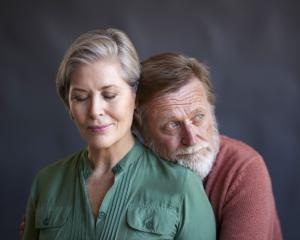Milford is presenting a show of new works by leading New Zealand artists, with all five providing delights for the viewer.
Andy Leleisi'uao's paintings continue his mysterious, evocative narratives, dominated by bold black and white images accented in red. The personal language and mythology used show an underworld, its characters breaking free into an upper, exterior landscape in a series of forcefully worked canvases.
A Pasifika mythology is also presented in two powerful photographic images by Shigeyuki Kihara, whose other work explores early photographic tourist myth-making in the islands.
Reuben Paterson's mastery of the unusual, demanding medium of glitter is well shown in three works inspired by textiles, and even more so in the cascading flow of Owharoa.
Neil Dawson's two fine, metallic wall sculptures use a repeated motif of birds in flight to form angel wings and vortices. In an extrapolation on his previous play with light and shadow, he has painted the backs of these works in fluorescent colour, allowing a softly coloured reflected wash to cushion the works on the wall behind.
Michael Hight completes the exhibition with four deft pastoral scenes. It is the largest of these which tops the display - a sumptuous epic panorama of the Taramakau River that excellently displays the artist's eye and hand.
At first glance, pairing Greg Lewis, best known for his strong, low-key portraits, and Inge Doesburg, with her delicate, shimmering landscapes, seems an odd idea. The Artist's Room gallery shows, however, that it is an inspired combination.
Whether by design or coincidence, the two artists have closed in style. Inge Doesburg's broad, panoramic vistas have gained weight and substance, while retaining the spinning airiness in which skies becomes tangible, voluminous yet solid. There has been considerable experimentation in the materials used as bases for the works, with several landscapes being presented as if painted on to ceramic plates, and other works layered on copper sheet. The latter of these works are most impressive, with the sheen of the metal adding a deep lustrous glow to the landforms depicted.
Greg Lewis, meanwhile, has presented an array of different works. Portraits are still present, on this occasion four character studies taken from stills of spaghetti Westerns. Several graphite images are also displayed, using the artist's conceit of framing them as pages torn from some old book. Most interestingly, though, Lewis has produced a handful of mountain landscapes, their subject and style blending and merging effectively with those of Doesburg. Lewis' works are capped by a large, impressive character study of a nocturnal hunter.
"The land show" is an apt subtitle for the group show at Blue Oyster. Though employing many different media and styles, the nine artists' works are all directly or indirectly connected to human impact upon the land.
One of Sophie Jerram's "men of the land", a life-sized photographic cut-out of a rural worker, welcomes visitors to the gallery.
Other photographic works on display include Mizuho Nishioka's cold, effective studies of human marks on the landscape, and Karim Sahai's effective juxtaposition of urban and rural North Korean scenes.
Mark Bolland adds to the photographic mix with three images, notably an atmospheric, misty image of Lovers' Leap on Otago Peninsula.
Videos make up a third of the works on display, with works by Jane Zusters, Kate Belton and Max Bellamy.
Bellamy's disorienting work, with its drift of power pylons passing to the thrum of an electronic ambient soundscape is perhaps the most notable of these.
The two final works are a quixotic kinetic work by Johnathon Titheridge and a large-scale floor map by Sebastian Warne. The latter's primal river valley flooded with a river of hot glue unnervingly but effectively conjures up connotations of bodily fluid as much as river flow, again connecting us with our environment.












